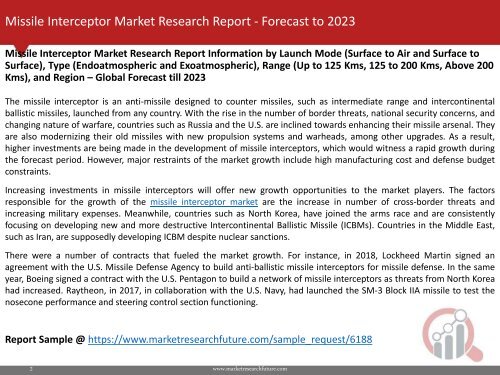Missile Interceptor
Create successful ePaper yourself
Turn your PDF publications into a flip-book with our unique Google optimized e-Paper software.
<strong>Missile</strong> <strong>Interceptor</strong> Market Research Report - Forecast to 2023<br />
<strong>Missile</strong> <strong>Interceptor</strong> Market Research Report Information by Launch Mode (Surface to Air and Surface to<br />
Surface), Type (Endoatmospheric and Exoatmospheric), Range (Up to 125 Kms, 125 to 200 Kms, Above 200<br />
Kms), and Region – Global Forecast till 2023<br />
The missile interceptor is an anti-missile designed to counter missiles, such as intermediate range and intercontinental<br />
ballistic missiles, launched from any country. With the rise in the number of border threats, national security concerns, and<br />
changing nature of warfare, countries such as Russia and the U.S. are inclined towards enhancing their missile arsenal. They<br />
are also modernizing their old missiles with new propulsion systems and warheads, among other upgrades. As a result,<br />
higher investments are being made in the development of missile interceptors, which would witness a rapid growth during<br />
the forecast period. However, major restraints of the market growth include high manufacturing cost and defense budget<br />
constraints.<br />
Increasing investments in missile interceptors will offer new growth opportunities to the market players. The factors<br />
responsible for the growth of the missile interceptor market are the increase in number of cross-border threats and<br />
increasing military expenses. Meanwhile, countries such as North Korea, have joined the arms race and are consistently<br />
focusing on developing new and more destructive Intercontinental Ballistic <strong>Missile</strong> (ICBMs). Countries in the Middle East,<br />
such as Iran, are supposedly developing ICBM despite nuclear sanctions.<br />
There were a number of contracts that fueled the market growth. For instance, in 2018, Lockheed Martin signed an<br />
agreement with the U.S. <strong>Missile</strong> Defense Agency to build anti-ballistic missile interceptors for missile defense. In the same<br />
year, Boeing signed a contract with the U.S. Pentagon to build a network of missile interceptors as threats from North Korea<br />
had increased. Raytheon, in 2017, in collaboration with the U.S. Navy, had launched the SM-3 Block IIA missile to test the<br />
nosecone performance and steering control section functioning.<br />
Report Sample @ https://www.marketresearchfuture.com/sample_request/6188<br />
2<br />
www.marketresearchfuture.com


















